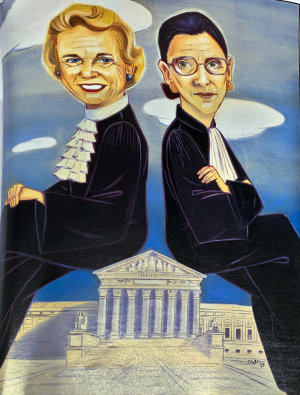Law’s Smallest Club
June 1, 2003

DISCLAIMER: This text has been transcribed automatically and may contain substantial inaccuracies due to the limitations of automatic transcription technology. This transcript is intended only to make the content of this document more easily discoverable and searchable. If you would like to quote the exact text of this document in any piece of work or research, please view the original using the link above and gather your quote directly from the source. The Sandra Day O'Connor Institute does not warrant, represent, or guarantee in any way that the text below is accurate.
Article Text
(Excerpt, Automatically generated)
Sandra Day O'Connor and Ruth Bader Ginsburg are polar opposites with abiding bonds.
AS USUAL, SANDRA DAY O'CONNOR WAS the first U.S. Supreme Court justice to pose a question during an oral argument. It was early this spring and at issue was the constitutionality of limiting visits to prison inmates. "Does the right to association while in prison survive in some form, do you think?" she asked Michigan solicitor general Thomas Casey, who was defending the regulations at issue in Overton v. Bazzetta. The right to a relationship survives, Casey suggested, but not necessarily any right to activities that further a relationship--such as visitation. Before O'Connor could follow up, the discussion took another turn. But Justice Ruth Bader Ginsburg chimed in a few minutes later, asking Casey to "back up to where you were when you were responding to Justice O'Connor's question. Ginsburg asked him directly, "Do I take it that your position is ... there is absolutely no right to any visitation?" When Casey replied yes, O'Connor leaned forward and interjected acidly, "Do you have a fallback position from that and if so, what is it?"
It was a rare but striking example of the O'Connor-Ginsburg one-two punch, in which one of the Court's two female justices makes sure an advocate does not slip away from the questioning of the other. As Ginsburg nears her tenth anniversary on the nation's highest court-and O'Connor closes in on her twenty-second-the relationship between the Court's first and
